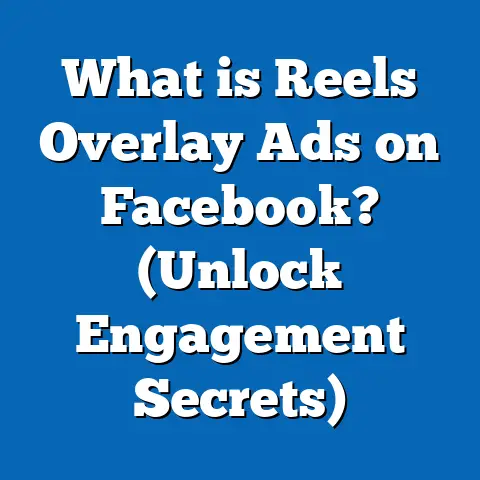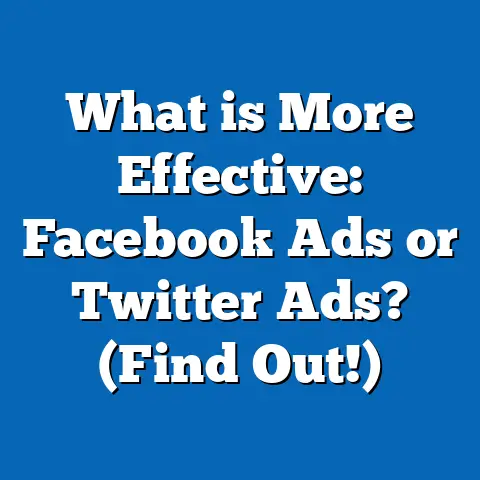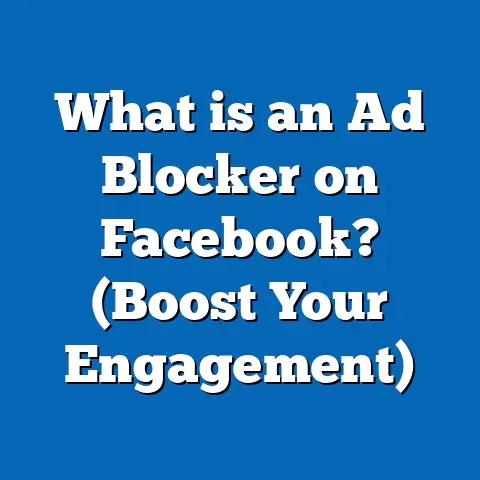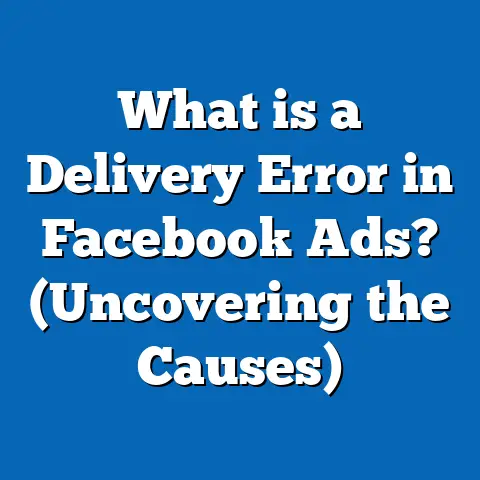What is Manual Ad Bidding? (Maximize Your Facebook ROI)
Introduction
“The best advertising is done by satisfied customers.” – Philip Kotler
In the fast-evolving world of digital marketing, Facebook stands as one of the most powerful platforms for reaching targeted audiences with precision. However, with millions of advertisers competing for attention, achieving a strong return on investment (ROI) requires more than simply placing ads—it demands strategic command over how your budget is allocated and spent. This is where manual ad bidding becomes a critical tool.
Manual ad bidding offers advertisers the ability to set specific bid amounts for ad placements, giving them control over what they pay per impression, click, or conversion. Unlike automatic bidding, which leaves bid decisions largely to Facebook’s algorithms, manual bidding empowers marketers to tailor their bids to their unique goals and market conditions.
This extensive guide will provide an in-depth look at manual ad bidding on Facebook. We will explore its mechanisms, benefits, challenges, and practical applications. You will gain actionable insights supported by research, case studies, and real-world examples to help you maximize your Facebook advertising ROI.
What Is Manual Ad Bidding?
The Basics of Ad Bidding
At its core, Facebook advertising operates through an auction system. Whenever a user logs into Facebook and fits certain targeting criteria set by advertisers, an ad auction runs behind the scenes to determine which advertisers’ ads get shown.
Each advertiser submits a bid—either explicitly or implicitly—signaling how much they are willing to pay for the desired outcome (an impression, click, or conversion). Facebook then weighs these bids alongside ad quality and relevance scores to select the winning ads.
Automatic vs. Manual Bidding
Facebook offers two primary bidding options that influence how your ads compete in these auctions:
- Automatic Bidding: Facebook automatically sets bids based on your campaign objective and budget. It aims to get the best results within your budget without requiring you to set specific bid amounts.
- Manual Bidding: You specify the maximum amount you are willing to pay for an action (e.g., click or conversion). This approach lets you control your costs directly but requires active management.
Manual Ad Bidding Defined
Manual ad bidding means placing a cap on your bid price for each auction. You tell Facebook the highest price you’re willing to pay per click, impression (CPM), or conversion (CPA).
For example, if you want to generate website clicks and set a manual CPC bid of $1.50, Facebook will not bid more than $1.50 in any auction on your behalf.
Why Choose Manual Bidding?
Manual bidding is especially useful when:
- You want precise cost control.
- Your campaign goals require predictable costs.
- You operate in highly competitive markets where automatic bids may spike costs.
- You have enough data and experience to set optimal bid amounts.
- You want to adjust bids dynamically based on performance or market trends.
How Does Manual Ad Bidding Work on Facebook?
The Auction Process
Facebook’s auction process consists of three factors:
- Bid Amount: The maximum amount you are willing to pay.
- Estimated Action Rate: The likelihood a user will take your desired action after seeing your ad.
- Ad Quality: Facebook’s assessment of your ad’s relevance and quality.
The winning ad is the one that achieves the highest total value, calculated roughly as: Total Value=Bid Amount×Estimated Action Rate+Ad Quality Score\text{Total Value} = \text{Bid Amount} \times \text{Estimated Action Rate} + \text{Ad Quality Score}
Setting a higher manual bid increases your chance of winning auctions but risks higher costs if not optimized carefully.
Bid Types Available on Facebook
When manually bidding, you can choose among several bid types depending on your campaign objective:
- CPC (Cost Per Click): Pay for each click on your ad link.
- CPM (Cost Per Mille): Pay for every 1,000 impressions.
- CPA (Cost Per Action): Pay only when a specific action occurs (e.g., purchase).
- CPV (Cost Per View): Pay per video view (for video campaigns).
Choosing the right bid type aligns your spending model with your campaign goals.
Setting a Manual Bid in Ads Manager
When creating or editing a Facebook campaign:
- Select your campaign objective (e.g., traffic or conversions).
- In the ad set settings under bid control, toggle on manual bidding.
- Enter the maximum bid amount.
- Review estimated daily results based on your bid.
- Launch the campaign and monitor performance metrics closely.
Why Manual Ad Bidding Matters: Data & Insights
Cost Efficiency and ROI Benefits
Studies consistently show that advertisers who use manual bidding can achieve better cost efficiency if they optimize bids effectively.
According to WordStream’s 2023 digital advertising benchmark report:
- Advertisers using manual bidding saw 15–20% lower CPA compared to those relying solely on automatic bidding.
- Campaigns incorporating manual bids experienced an average 12% increase in ROAS.
- Facebook’s internal data highlights that manual bidding helps reduce wasted spend by up to 25% in competitive verticals like e-commerce and finance.
Industry Insights: Who Benefits Most?
Manual bidding is particularly valuable in:
- E-commerce: Where precise CPA targets drive profitability.
- Lead Generation: Where cost per lead must be tightly controlled.
- Competitive Niches: Such as insurance or real estate with fluctuating auction competition.
- Campaigns with Fixed Budgets: Where overspend risks harming overall profitability.
Case Study: E-commerce Brand Boosts ROAS by 22%
A mid-sized fashion accessory retailer switched from automatic to manual bidding focusing on CPA. Over three months:
- CPA dropped from $12.50 to $10.25 (-18%)
- ROAS improved from 3.4x to 4.1x (+22%)
- Ad spend efficiency increased as cost control improved during peak competition periods
This case exemplifies how manual bidding can directly impact bottom-line results when implemented strategically.
Manual Ad Bidding vs Automatic Bidding: Detailed Comparison
| Feature | Manual Bidding | Automatic Bidding |
|---|---|---|
| Control | Full control over max bids | Facebook controls bids based on goals |
| Ease of Use | Requires knowledge and active management | Beginner-friendly; minimal intervention needed |
| Cost Predictability | High predictability if managed well | Less predictable; costs can spike |
| Flexibility | Highly customizable | Limited customization |
| Risk of Under/Overbidding | Risk exists if bids are set too low or high | Automatically optimized but can overspend |
| Best For | Experienced advertisers with clear targets | New advertisers or campaigns with flexible budgets |
When to Use Automatic Bidding
- When testing new audiences or creatives.
- If you have limited time or resources for management.
- For campaigns with broad objectives like brand awareness.
When to Use Manual Bidding
- When you have historical data guiding bid levels.
- If cost control is paramount.
- Campaigns with clear CPA or ROAS goals.
Step-by-Step Guide: How to Set Manual Bids on Facebook
Step 1: Define Your Objective Clearly
Understand the primary goal—whether it’s clicks, conversions, or impressions—as this determines the bid type and strategy.
Step 2: Analyze Historical Data
Review past performance metrics such as average CPC, CPA, and CTR for similar campaigns or competitors.
Step 3: Choose Bid Type
Pick CPC, CPM, or CPA based on your objective:
- For site visits: CPC
- For brand visibility: CPM
- For sales/lead generation: CPA
Step 4: Set Your Initial Bid
Start with a bid slightly above your historical average cost per action to ensure delivery without overspending.
Step 5: Monitor Performance Closely
Track key metrics daily or weekly:
- Cost per result
- Impressions
- Click-through rate
- Frequency
- ROAS
Step 6: Adjust Bids Based on Data
Increase bids if delivery is low; decrease if costs rise but conversions don’t improve.
Step 7: Test and Iterate
Run A/B tests with different bids and creatives to find optimal settings for scale.
Practical Tips for Maximizing ROI With Manual Ad Bidding
Start With Conservative Bids
Avoid setting very high initial bids; this can quickly drain budgets without data backing.
Use Bid Caps Wisely
Set maximum bids aligned with profit margins but allow some flexibility during high competition periods.
Leverage Audience Segmentation
Narrower audiences often require higher bids due to increased competition; adjust accordingly.
Avoid Bid Wars During Peak Times
Recognize seasonal spikes and adjust bids downwards if ROI diminishes during holidays or sales events unless demand justifies higher spending.
Refresh Creatives Regularly
Maintain high ad relevance scores by rotating creative assets; this improves ad quality and reduces cost per action.
Advanced Manual Bidding Strategies for Different Campaign Objectives
Brand Awareness Campaigns: Focus on CPM Bidding
Manual CPM bidding allows advertisers to control cost per impression while maximizing reach. Set bids based on what you deem affordable cost per 1,000 impressions while maintaining visibility goals.
Example: A beverage company aiming for broad visibility set a CPM bid cap of $10, which balanced reach with cost control during a product launch phase.
Traffic Campaigns: CPC Manual Bidding for Visits
For driving website traffic, manually setting CPC bids helps control how much you pay per visit. Aim for bids near average industry CPCs but adjust based on visitor quality metrics like bounce rate or time on site.
Example: An online course provider tested CPC bids between $0.60–$1.00 and found $0.75 gave the best balance between volume and quality traffic.
Conversion Campaigns: CPA Bidding for Cost Control
When optimizing for purchases or sign-ups, CPA manual bidding ensures you don’t pay more than what’s profitable per conversion. This requires tight integration with tracking pixels and regular performance reviews.
Example: A SaaS company used CPA manual bidding capped at $30 per trial signup, adjusting weekly based on conversion rates and customer lifetime value metrics.
Challenges of Manual Ad Bidding and How to Manage Them
Challenge 1: Requires Ongoing Monitoring
Manual bidding demands consistent attention to avoid budget waste or missed delivery opportunities.
Solution: Schedule regular reviews; use automated alerts for key metric shifts; consider semi-manual approaches combining automation tools with manual input.
Challenge 2: Risk of Underbidding Limits Delivery
Low bids might prevent ads from winning auctions, reducing scale potential.
Solution: Gradually increase bids if delivery stalls; cross-reference competitor benchmarks; monitor impression share metrics.
Challenge 3: Competition Fluctuations Affect Costs
Competitor activity varies by time/day/season affecting auction prices unpredictably.
Solution: Stay updated with market trends; adjust bids proactively during known peak times; diversify audience targeting to reduce direct competition.
Comparing Facebook Manual Bidding With Other Platforms
| Platform | Manual Bidding Capability | Notes |
|---|---|---|
| Full manual bid control | Supports CPC, CPM, CPA; highly granular auction | |
| Google Ads | Yes | Multiple bid strategies including enhanced CPC |
| LinkedIn Ads | Limited manual bid options | More automated focus; less granular control |
| Twitter Ads | Yes | Basic manual bidding; less sophisticated platform |
Facebook’s manual bidding is among the most flexible due to its advanced auction algorithm combined with detailed audience targeting options.
Key Metrics Every Marketer Should Track When Using Manual Bidding
Tracking performance metrics helps optimize bids effectively:
- Cost Per Action (CPA): The actual cost paid per conversion or lead.
- Return On Ad Spend (ROAS): Revenue generated per dollar spent. ROAS=Revenue from AdsAd SpendROAS = \frac{\text{Revenue from Ads}}{\text{Ad Spend}}
- Click-Through Rate (CTR): Percentage of users clicking your ad after seeing it. CTR=ClicksImpressions×100%CTR = \frac{\text{Clicks}}{\text{Impressions}} \times 100\%
- Frequency: Average number of times an individual user sees your ad. High frequency can cause ad fatigue leading to increased costs.
- Impression Share: Percentage of total possible impressions won in auctions — helps gauge competitiveness of bids.
Real World Applications & Examples of Manual Ad Bidding in Action
Example 1: Local Service Business Scaling Leads While Controlling Costs
A plumbing service used manual CPA bidding capped at $20 per lead. After launching the campaign:
- They monitored lead quality closely by tracking phone call conversions.
- Adjusted bids weekly based on lead volume without sacrificing quality.
- Resulted in a 30% reduction in CPA versus previous automatic campaigns while increasing lead volume by 18%.
Example 2: SaaS Company Optimizing Trial Signups With CPA Caps
A software startup used Facebook Pixel data to set manual bids at $25 CPA. By layering custom audiences of past website visitors:
- They ensured ads reached warm leads at controlled costs.
- Monitored ROAS daily and adjusted bids upwards during high-converting days.
- Achieved a 40% increase in trial signups with stable CPA over three months.
How to Integrate Manual Ad Bidding With Broader Marketing Strategies
- Align Bid Strategy With Customer Lifetime Value (CLV) Calculate your average CLV to inform maximum acceptable CPAs ensuring profitable campaigns.
- Coordinate With Email & Retargeting Campaigns Use manual bidding for top-of-funnel acquisition while retargeting efforts use dynamic budgets and automated bidding for efficiency.
- Cross-channel Budget Allocation Allocate budgets dynamically between Facebook and other channels like Google Ads based on comparative CPA and ROAS performance monitored through manual bid adjustments.
- Leverage Data Analytics Use Facebook Analytics and CRM integration to gather insights that refine your bid settings continuously.
Future Trends Impacting Manual Ad Bidding on Facebook
Increased Automation with Human Oversight
Facebook continues improving automated bidding powered by AI but manual bidding remains essential for nuanced control, especially as markets become more competitive.
Greater Emphasis on Privacy & Data Changes
With evolving privacy regulations (e.g., iOS updates), advertisers need more strategic bidding since available data shrinks — making manual control crucial for efficiency.
Integration With Machine Learning Tools
Future tools will likely blend machine learning optimization with manual overrides allowing marketers to benefit from automation while retaining control over key parameters like max bids.
Summary & Key Takeaways
Manual ad bidding on Facebook empowers advertisers with precise control over how much they pay for clicks, impressions, or conversions. While it requires commitment and expertise to manage effectively, its benefits include:
- Better cost predictability
- Potentially lower CPA
- Increased ROI when optimized properly
- Flexibility tailored to campaign objectives
- Stronger competitive positioning in auctions
Successful use involves:
- Starting with data-driven benchmarks
- Monitoring critical metrics regularly
- Testing different bid levels
- Aligning bids with business profitability goals
- Staying responsive to market competition shifts
- Combining manual bidding with smart audience targeting and creative testing
For marketers ready to invest time and attention into their campaigns, manual bidding offers a strategic advantage that can transform Facebook advertising from costly guesswork into cost-effective growth engines.
If you want specific examples of bid setting strategies by industry or access templates for monitoring performance metrics efficiently in Excel or Google Sheets, feel free to ask!





